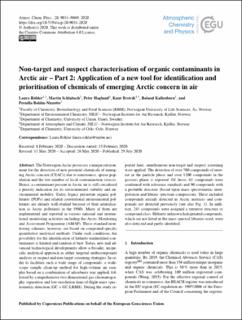| dc.contributor.author | Röhler, Laura | |
| dc.contributor.author | Schlabach, Martin | |
| dc.contributor.author | Haglund, Peter | |
| dc.contributor.author | Breivik, Knut | |
| dc.contributor.author | Kallenborn, Roland | |
| dc.contributor.author | Bohlin-Nizzetto, Pernilla | |
| dc.date.accessioned | 2020-08-04T09:47:50Z | |
| dc.date.available | 2020-08-04T09:47:50Z | |
| dc.date.created | 2020-07-29T17:16:00Z | |
| dc.date.issued | 2020 | |
| dc.identifier.citation | Atmospheric Chemistry and Physics. 2020, 20, 9031-9049. | en_US |
| dc.identifier.issn | 1680-7316 | |
| dc.identifier.uri | https://hdl.handle.net/11250/2670739 | |
| dc.description.abstract | The Norwegian Arctic possesses a unique environment for the detection of new potential chemicals of emerging Arctic concern (CEACs) due to remoteness, sparse population and the low number of local contamination sources. Hence, a contaminant present in Arctic air is still considered a priority indication for its environmental stability and environmental mobility. Today, legacy persistent organic pollutants (POPs) and related conventional environmental pollutants are already well-studied because of their identification as Arctic pollutants in the 1980s. Many of them are implemented and reported in various national and international monitoring activities including the Arctic Monitoring and Assessment Programme (AMAP). These standard monitoring schemes, however, are based on compound-specific quantitative analytical methods. Under such conditions, the possibility for the identification of hitherto unidentified contaminants is limited and random at best. Today, new and advanced technological developments allow a broader, unspecific analytical approach as either targeted multicomponent analysis or suspect and non-target screening strategies. In order to facilitate such a wide range of compounds, a wide-scope sample clean-up method for high-volume air samples based on a combination of adsorbents was applied, followed by comprehensive two-dimensional gas chromatography separation and low-resolution time-of-flight mass spectrometric detection (GC × GC-LRMS). During the study reported here, simultaneous non-target and suspect screening were applied. The detection of over 700 compounds of interest in the particle phase and over 1200 compounds in the gaseous phase is reported. Of those, 62 compounds were confirmed with reference standards and 90 compounds with a probable structure (based upon mass spectrometric interpretation and library spectrum comparison). These included compounds already detected in Arctic matrices and compounds not detected previously (see also Fig. 1). In addition, 241 compounds were assigned a tentative structure or compound class. Hitherto unknown halogenated compounds, which are not listed in the mass spectral libraries used, were also detected and partly identified. | en_US |
| dc.language.iso | eng | en_US |
| dc.rights | Navngivelse 4.0 Internasjonal | * |
| dc.rights.uri | http://creativecommons.org/licenses/by/4.0/deed.no | * |
| dc.title | Non-target and suspect characterisation of organic contaminants in Arctic air – Part 2: Application of a new tool for identification and prioritisation of chemicals of emerging Arctic concern in air | en_US |
| dc.type | Peer reviewed | en_US |
| dc.type | Journal article | en_US |
| dc.description.version | publishedVersion | en_US |
| dc.rights.holder | © Author(s) 2020. | en_US |
| dc.source.pagenumber | 9031-9049 | en_US |
| dc.source.volume | 20 | en_US |
| dc.source.journal | Atmospheric Chemistry and Physics | en_US |
| dc.identifier.doi | 10.5194/acp-20-9031-2020 | |
| dc.identifier.cristin | 1820988 | |
| dc.relation.project | Norges forskningsråd: 267574 | en_US |
| dc.relation.project | NILU - Norsk institutt for luftforskning: 116037 | en_US |
| dc.relation.project | NILU - Norsk institutt for luftforskning: 111088 | en_US |
| dc.relation.project | NMBU - Norges miljø- og biovitenskapelige universitet: 1205051013 | en_US |
| cristin.ispublished | true | |
| cristin.fulltext | original | |
| cristin.qualitycode | 2 | |

